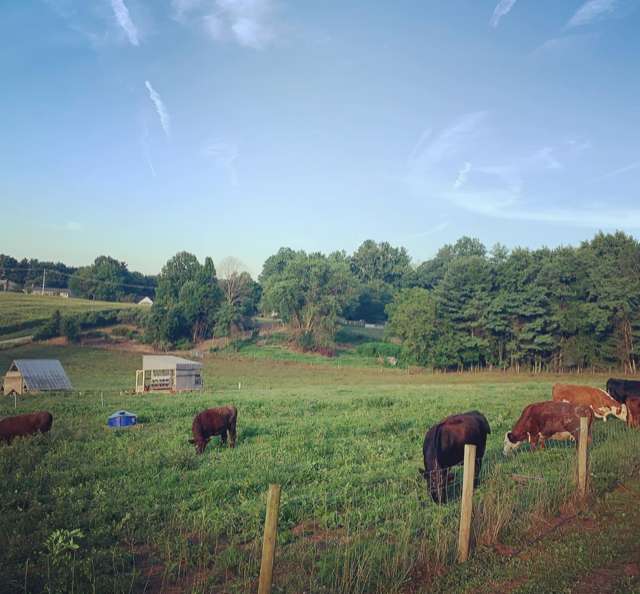Rendering Tallow at Home (and why we love it so much!)
posted on
January 19, 2022
Grass-fed beef tallow is a versatile ingredient to have in the kitchen – and around your home in general. With so many possible uses, why not save some money and render it yourself?

It may seem like a daunting task, especially when you first pull that big hunk of suet out of the package! Fear not, as it’s mostly a hands off, straight-forward process that will reward you with a bounty of gorgeous tallow. Keep reading for step-by-step directions below. But first, we want to share a bit of our knowledge and love with you!
True tallow will be rendered from a section of fat that surrounds the kidneys. This fat is called suet. While you could definitely render fat from other areas (even trimmings from roasts, etc.), it wouldn’t be of such excellent quality. Suet will render into a more pure and clean smelling and tasting final product. Another reason suet is King in the beef fat realm is because it has extra concentrations of so many vitamins and nourishment our bodies love and need! Packed with vitamins A, D, K, E and B12, as well as CLA (conjugated Linoleic Acid) and a host of other vital nutrients.
Fact: Tallow from conventionally farmed beef would ultimately not be a healthy choice. Why not? Because it’s coming from an unhealthy animal and toxins accumulate in fat. You will not find this in our 100% grass-fed beef fat from happy animals.
Our favorite way to use tallow is in the kitchen. It has a smoke point of 420-degrees, making it excellent for roasting and sautéing at high temps and especially for deep-frying. A quick internet search will show you how it wasn’t until the last few decades that most fast-food chains made the switch from tallow to cheaper processed vegetable oils. While fries that are plunged into bubbling-hot tallow will undoubtedly be the most delicious you’ve ever had, a healthier option would be to use it for sautéing or roasting vegetables.

These Brussels sprouts were tossed into a pan of hot tallow left-over from preparing a steak, then thrown right back into the hot oven. They were so easy and by-far the best Brussels I’ve ever had. So good in fact, I made them two days in a row for dinner and the cravings haven’t stopped. Guess I’ll be having them again tonight! I think I have to mix it up a bit and at least throw some broccoli and cauliflower in, maybe even some cabbage and onion hunks yummm…
Anyway, hopefully you get the idea that tallow creates dream-worthy meals with ease. You will be sure to see more of our recipes calling for tallow as the first-choice cooking fat, so get prepared!
What are other ways one could use tallow? Tallow, along with lard (rendered pork fat), were once staples in every household. It is an ideal fat for making soap and candles, seasoning cast iron pans, greasing and protecting metal elements from corrosion, conditioning and waterproofing leather and other materials and using it to moisturize and protect your skin. Tallow may seem like an odd choice for cleansing and moisturizing skin, but in fact, it is not at all. Its composition and pH resembles human cells more closely than any vegetable or seed oil used commonly in the skin-care and cosmetic market. It is ideal for healing skin, as well as an excellent protectant from the wind.

How does one store tallow? It can be stored in an airtight container, away from sunlight at room temperature for up to a year. In order to prevent spoilage, use only clean utensils to scoop from your jar. Using anything but that will introduce bacteria that will cause the tallow to spoil rapidly. You may also store it in the refrigerator or freezer. This is recommended if there was a possibility of contamination during use. The downside to this is that tallow at room temperature is very hard. Frozen tallow is nearly impossible to remove from a jar. If you are uncomfortable with shelf storage, you might want to consider creating tallow blocks with just a few extra steps. This would allow you to store them bagged in the freezer, and give you the ease of slicing off how much you want with a warmed knife. See more below.
The entire process, from pulling it out of the freezer to storing your finished tallow, can be done easily in one day with very little active hands-on time.
First, pull suet from freezer, remove packaging and allow to set on a large cutting board at room temp for about 30 minutes. You can gather your limited supplies for now; a knife, a bowl and a vessel for cooking. We rendered two sections, using both electric slow cookers and a Dutch oven for the sake of experimentation. Just one of these will be adequate for rendering one section of suet.

Once the tallow has begun to soften, you can start trimming. This is really way more pleasant than I had anticipated. The immediate goal is to remove any muscle tissue that remains on the under-side. Simply cut the bloody areas away and set aside. I rendered this separately in the smaller slow cooker and used for making winter bird treats – suet cakes for both wild birds and my backyard chickens.

You will notice a film on the suet, similar to plastic wrap. This is what ultimately cooks down into greaves or cracklings. You may choose to remove it to have less fibrous remainders floating in your rendered tallow. However, this step I found to be an unnecessary waste of time, as straining is required either way.

Next, you need to chop the suet into chunks no greater than 1” thick. The smaller you go, the more quickly it will render. But, not by much, and the final products are equal in quality. Once they are chopped, place them into an electric slow cooker on Low for 6-7 hours or into a Dutch oven, covered in the oven preheated to 225-degrees for 4-5 hours. No stirring needed.


Once you notice floaty bits that are beginning to brown, aka greaves or cracklings, you know your suet has been well-rendered and you can remove from the heat, lid off, to begin to cool a bit, about 30-60 minutes.

You’ll notice in the white bowls that my Dutch oven cracklings on the bottom are lighter in color and a bit more plump. That could’ve been rendered another 30 minutes or so, but I was side-tracked and didn’t want to risk burning the entire batch in order to render another ounce or so.

While your tallow is cooling a bit, you can go ahead and prep your “straining station”. I recommend using your sink or a large cutting board, as drips are bound to happen. You will need two large glass or ceramic bowls or measuring cups that can handle a small amount of heat shock, a small bowl for crackings, a slotted spoon, a metal mesh strainer and cheese cloth. I was unpleasantly surprised to find my cloth was missing, but a jelly bag worked perfectly in its place!

You will also want to prepare your containers or molds. Sanitized canning jars with clean, rust-free lids and rings are an ideal vat. If you choose to make bricks, you will want to gather baking sheets or roasting pans and line with parchment paper.
Scooping out the majority of the greaves/cracklings with a slotted spoon will make the straining process faster and less-messy, however, it is not necessary.

You can remove them to a dish before pouring warm tallow through the mesh strainer into a separate, large glass bowl.

Dump greaves into dish, spray strainer mostly clean with hot water and dry thoroughly. If water is introduced to this process, in time it will likely cause your tallow to become rancid.
Line the dry strainer with cheesecloth and strain tallow again, into a separate bowl.

Line up clean jars or lined pans to be filled. Place lids on jars and leave on a flat surface overnight to set up. Allow molds to set up overnight as well before slicing with a thread or gently with a warmed knife.


You can also pour warm (not hot!) tallow directly into molds with bird seed for feeders, or into jars with wicks for non-toxic candles.

I initially tossed the greaves into a baggy in the freezer before ultimately mixing with scratch and meal worms for the chickens and they loved it so much, I wish I had more! I’ve also heard them described as “beefy bacon-bits” when re-crisped and used as a meal topper.
The uses of tallow and it’s byproducts seem never ending. What is your favorite use?




